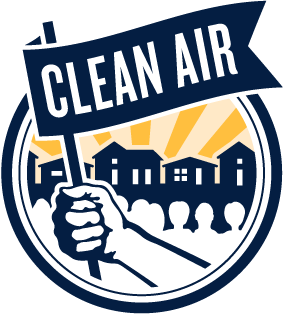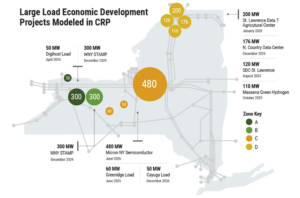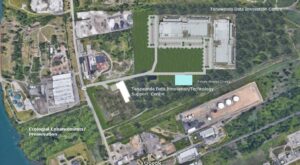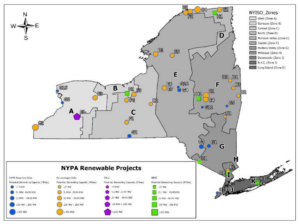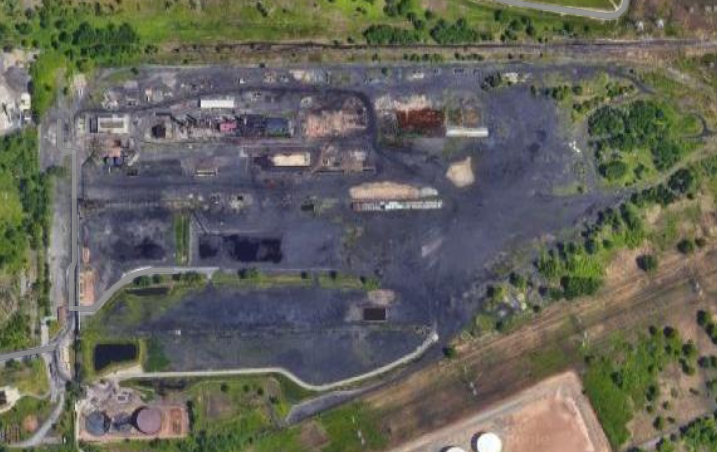We want renewable power, not data centers, at Tonawanda Coke!
Join us at NYPA’s Public Hearing on November 7 at at 6pm at the NYPA Power Vista at 5777 Lewiston Road in Lewiston NY! Carpools from Buffalo available.
NY is off track from our goals for a just transition off of fossil fuel-based energy onto renewables.
In part, this is due to the rise in data centers like those used for cryptocurrency mining, which is causing serious concerns about overall grid stability. Per the New York Independent System Operator, well over 500 MW of industrial power is currently modeled as expected demands on our power grid in coming years just from cryptocurrency mining operations at data centers.
In WNY, cryptocurrency mining operations have popped up in industrial corridors numerous times, most notably in Niagara Falls, where data centers caused such a nuisance that it spurred the city to develop a novel High Energy Use District zoning overlay, and North Tonawanda, where residents have been supported by Clean Air in their opposition to Digihost’s operations at the Fortistar gas-fired power plant for several years.
Cryptocurrency mining causes local environmental injustice concerns, most notably significant noise pollution and brownouts of the energy grid in environmental justice communities due to the extremely high energy demands.
The site owner for several of the cryptocurrency mining projects in Buffalo and Niagara Falls is Jon Williams, a brownfield developer who is also the current owner and developer for the former American Axle and Tonawanda Coke sites. American Axle, in addition to other operations, houses another Digihost mine, which pulls 42 Megawatts from the energy grid. Williams was, for a short time, a board member of Digihost, further cementing his direct connections with that company in particular, but he also has close ties to other firms, like US Bitcoin.
The stated desired site reuse for Tonawanda Coke primarily consists of a series of data centers – which, given Williams presence in the local cryptocurrency mining ecosystem, we should assume will mean cryptocurrency mining.
Residents who live adjacent to Tonawanda Coke, while grateful the stacks are down and that the site is being remediated, have strongly voiced opposition to cryptocurrency mining at TCC, and have expressed that they would prefer a more passive and generative use, like solar power generation.
Which brings us to our ask of our larger membership and the larger WNY community – please join us on November 7 at 6pm at the NYPA Power Vista at 5777 Lewiston Road in Lewiston. Register today to help us coordinate carpools.
For background – in 2023, NY passed the Build Public Renewables Act, which directs the New York Power Authority to plan, construct, and operate renewable energy projects in service of the state’s renewable energy goals. This is a groundbreaking and crucial piece of legislation, and Clean Air supported it’s passage.
With this new expanded authority and onus on NYPA to take action to develop renewable energy projects, NYPA then set to work to develop a plan, and on October 8 NYPA released the draft.
However, this plan falls far short – the plan is projected to develop 3.5 GW of renewable energy with a mix of private and public sector projects by 2030, which is multitudes short of what we need.
While it’s unclear where projects in NYISO Zone A are exactly proposed (see pages 36-47), what we can discern is that these projects do not appear to be primarily located on any of the numerous contaminated industrial brownfield sites in our region, which is a massive oversight and missed opportunity.
While much of the opposition to renewable energy development in our region stems from cynical self-serving interests like oil and gas producers and manufacturers, another large portion stems from genuine concern that our green open spaces and farmlands is being used for industrial purposes.
While we do not feel that the siting of these projects necessarily constitutes an environmental injustice as we define it, it certainly seems silly and generates unnecessary conflict, especially given the availability of vacant industrial brownfield parcels with readily available power connections already in place.
The lack of smaller, easily deployable community renewable energy generation projects, like solar on municipal buildings, also seems like a big oversight, and out of step with other current statewide initiatives.
Which brings us back to Tonawanda Coke – the Environmental Protection Agency conducted a nationwide analysis of the potential for renewable energy generation reuses of brownfield sites, including Tonawanda Coke, as part of the RE-Powering America’s Land Initiative.
What the analysis found is that the 3875 River Road brownfield parcel of Tonawanda Coke stands out as an excellent potential site for solar power generation, with an estimated Solar Photovoltaic (PV) Capacity of 13.11 MW, and close proximity to necessary grid connections from the former Huntley facility!
For context, the EPA uses the threshold of 5 MW as utility-scale solar power generation.
You don’t need to be an energy analyst to envision this – if you have been to the site, you know that today it is largely a flat surface, which gets full sun due to the lack of vegetation.
This also aligns with the community-developed goals of the Tonawanda Tomorrow Plan, explicitly calls for utility-scale solar generation in the River Road corridor.
Our Tonawanda Tomorrow Team is leaning into advocating for solar generation at Tonawanda Coke moving forward – and the upcoming NYPA hearings on the draft strategic plan, kicking off statewide with in-person hearings in Lewiston on November 7, presents us with a unique opportunity to present this demand to our state officials.
Please register to help us plan headcounts and coordinate carpools, and invite friends, family, and colleagues!
We want a big turnout – the more people in the room making a shared demand for additional renewable energy projects on vacant industrial brownfields, specifically at Tonawanda Coke, the greater the likelihood that NYPA will be spurred to direct future project development in this direction, and the greater the pressure on Jon Williams to choose this generative direction instead of a harmful energy draw like cryptocurrency mining for 3875 River Road becomes.
Please stay tuned for other upcoming related actions, like a digital comment form and actions for the virtual hearing on November 21. Want to get involved with our Tonawanda Tomorrow Team, or have questions or comments? Please email bridge.
RSS 2.0 feed. Both comments and pings are currently closed.
